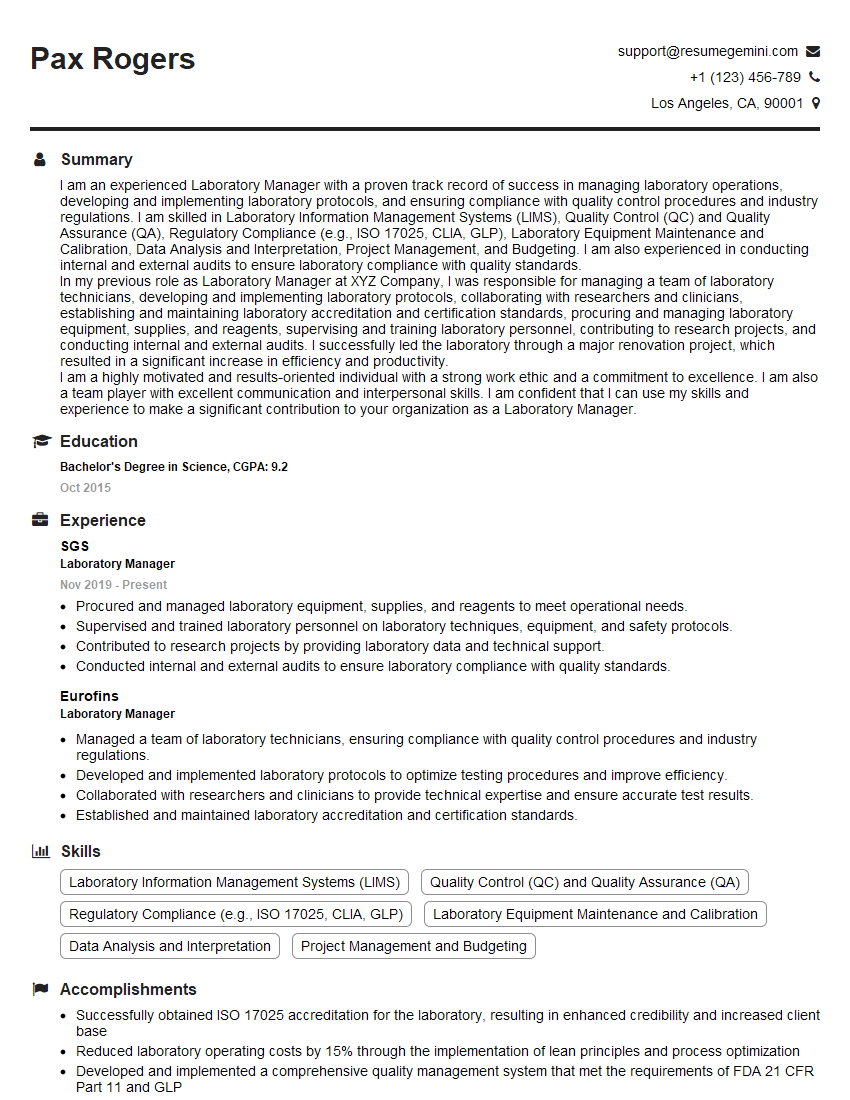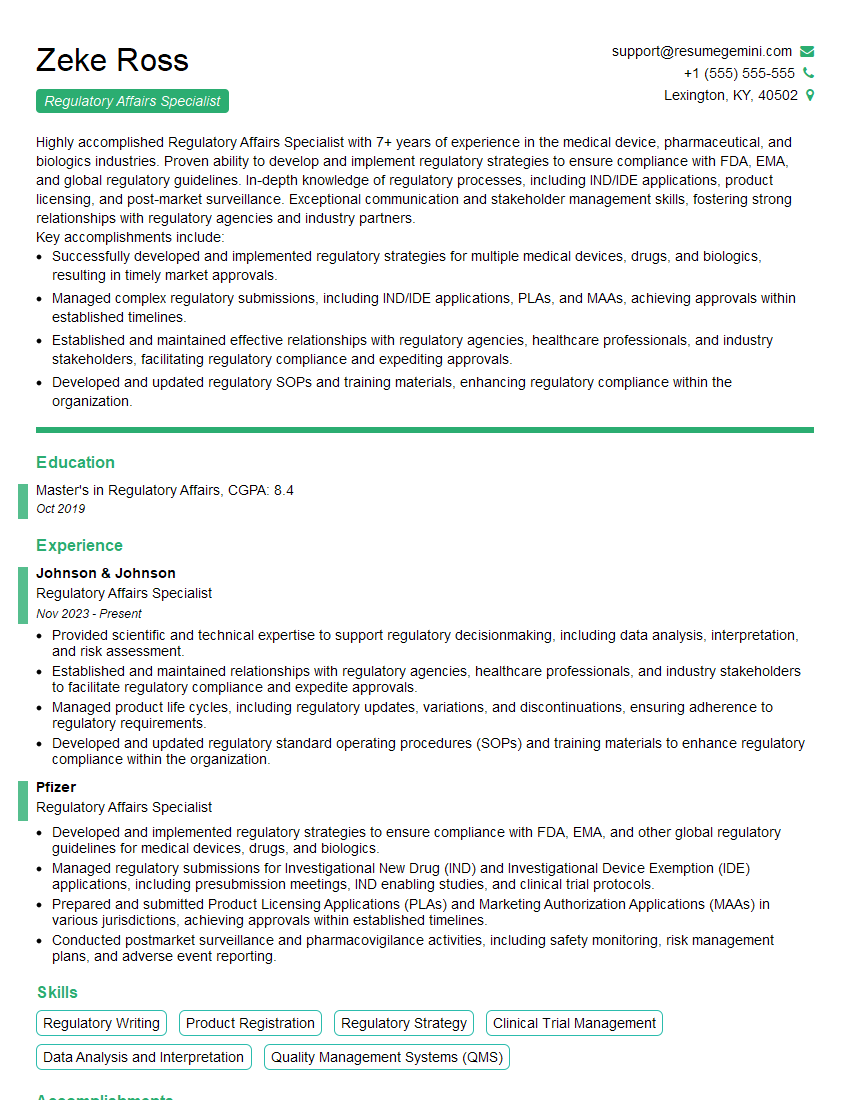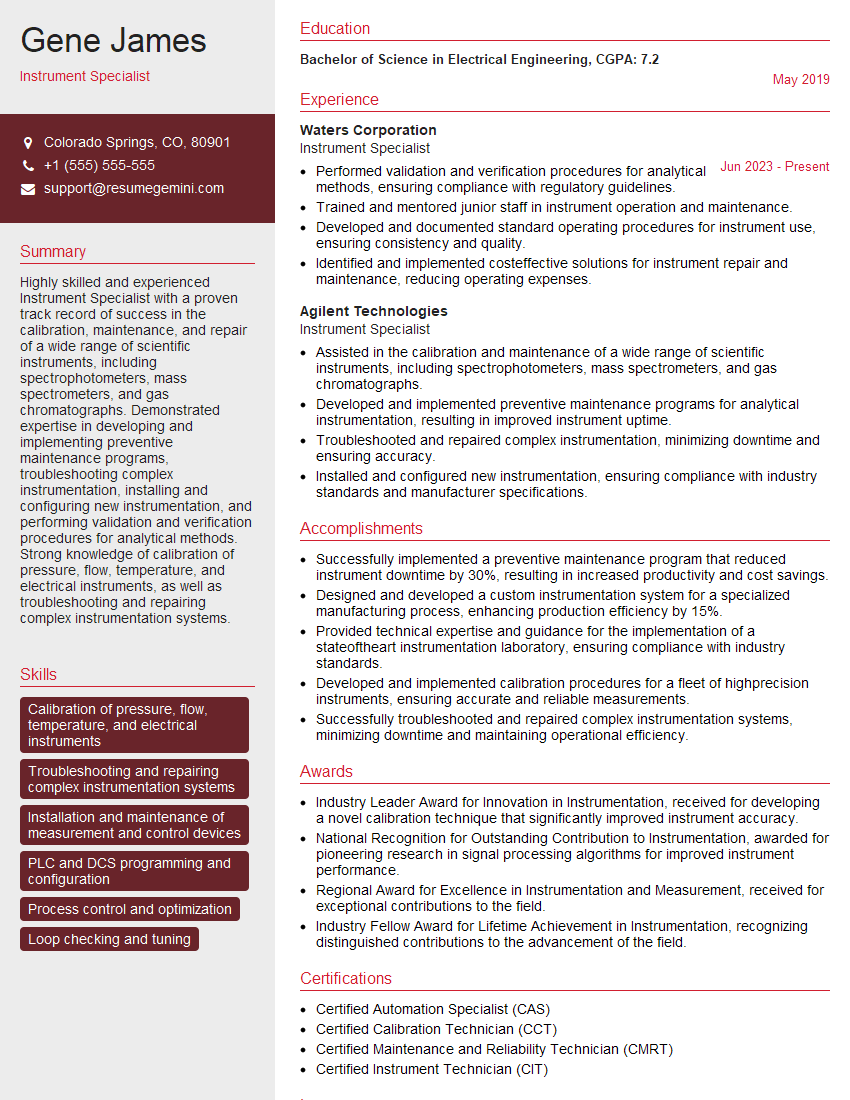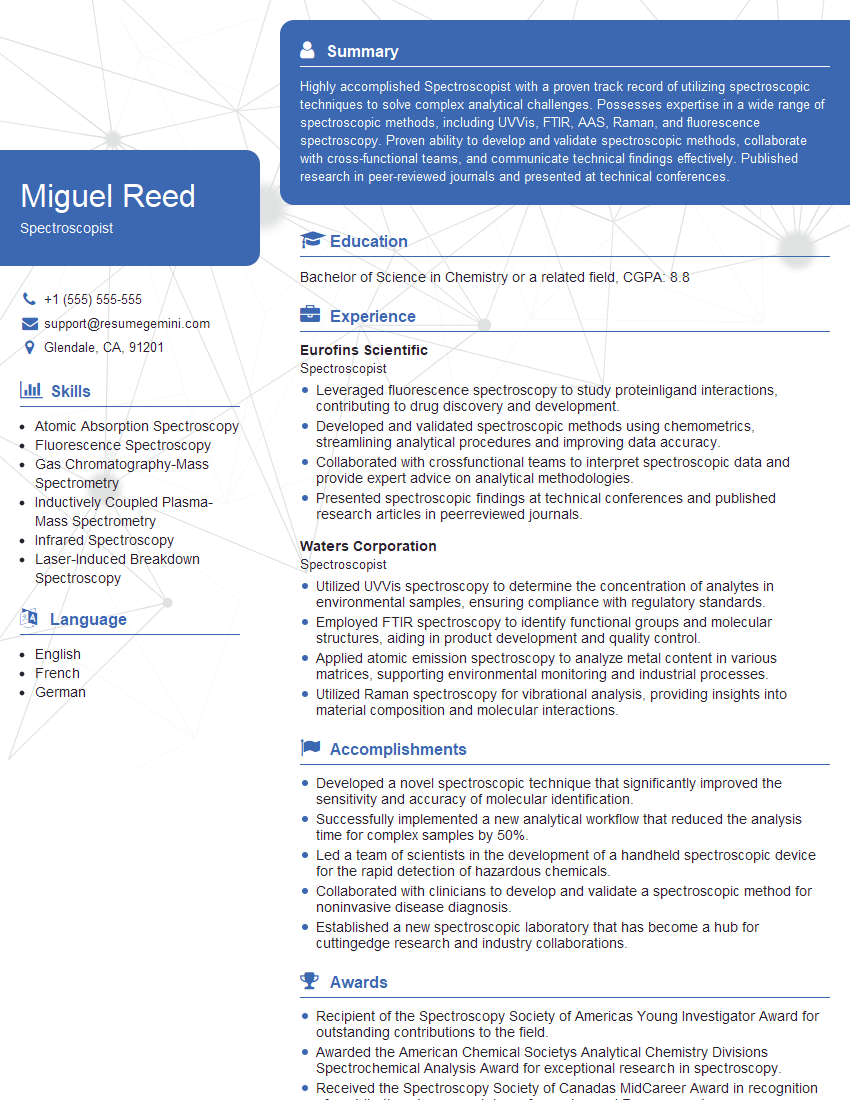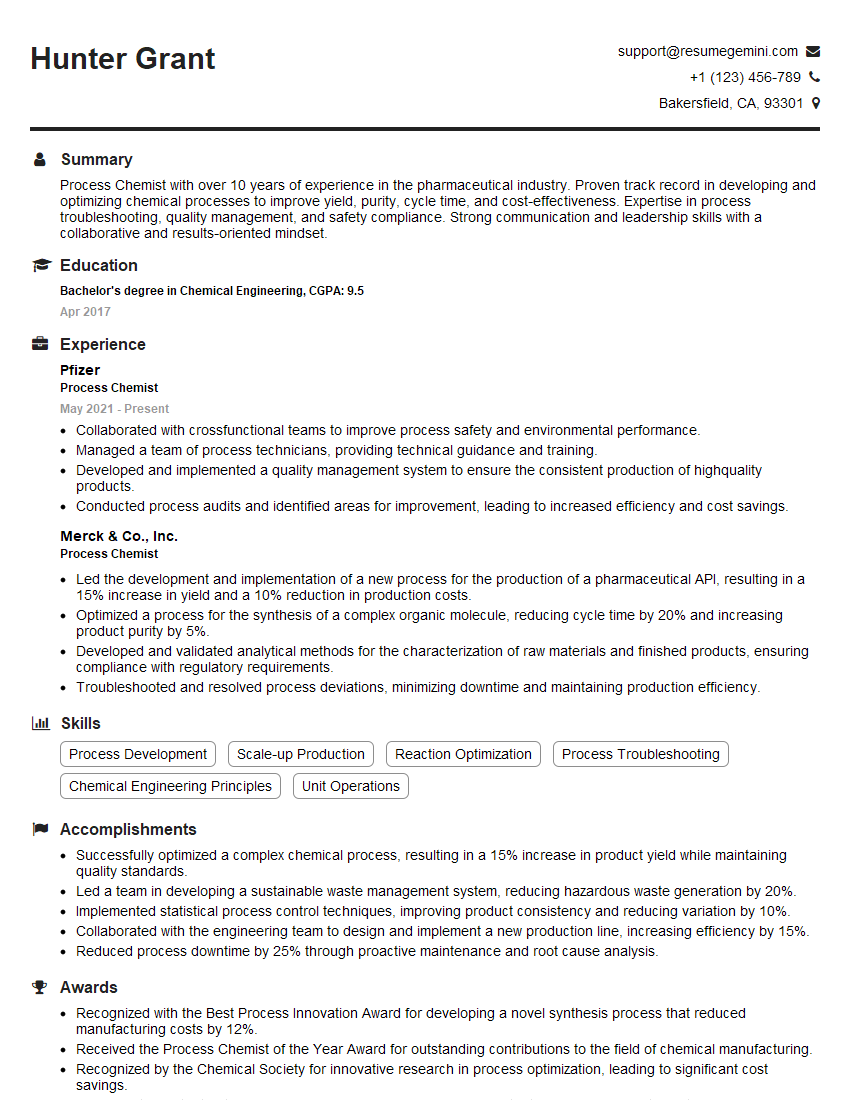The thought of an interview can be nerve-wracking, but the right preparation can make all the difference. Explore this comprehensive guide to Spectrophotometry and Chromatography Techniques interview questions and gain the confidence you need to showcase your abilities and secure the role.
Questions Asked in Spectrophotometry and Chromatography Techniques Interview
Q 1. Explain the Beer-Lambert Law and its limitations.
The Beer-Lambert Law is the foundation of spectrophotometry. It states that the absorbance of a solution is directly proportional to the concentration of the analyte and the path length of the light through the solution. Mathematically, it’s expressed as A = εbc, where A is absorbance, ε is the molar absorptivity (a constant specific to the analyte and wavelength), b is the path length, and c is the concentration.
Think of it like this: imagine shining a flashlight through a glass of colored water. The darker the water (higher concentration), the less light gets through (higher absorbance). Similarly, a longer glass (longer path length) will also absorb more light.
However, the Beer-Lambert Law has limitations. It only holds true under specific conditions. These include:
- Monochromatic light: The law assumes the light source is of a single wavelength. Polychromatic light can lead to deviations.
- Dilute solutions: At high concentrations, interactions between analyte molecules can affect absorbance, causing deviations from linearity.
- No chemical reactions: The analyte should not undergo any chemical reactions that alter its absorbance during measurement.
- No scattering or fluorescence: Scattering of light or fluorescence by the sample will interfere with accurate absorbance measurements.
For example, if you’re analyzing a highly concentrated protein solution, you might observe deviations from the Beer-Lambert Law because of protein-protein interactions. In such cases, sample dilution is necessary to ensure accurate measurements.
Q 2. Describe the different types of spectrophotometers and their applications.
Spectrophotometers come in various types, each suited for different applications:
- UV-Vis Spectrophotometers: These are the most common type, measuring absorbance in the ultraviolet (UV) and visible (Vis) regions of the electromagnetic spectrum (approximately 190-800 nm). They are widely used in quantitative analysis of various substances, from determining the concentration of proteins in a solution to analyzing the purity of a chemical compound.
- Infrared (IR) Spectrophotometers: These measure absorbance in the infrared region, providing information about the functional groups present in a molecule. They’re invaluable in identifying and characterizing unknown compounds, particularly in organic chemistry.
- Atomic Absorption Spectrophotometers (AAS): These are specifically designed to measure the concentration of metal ions in solution. They use a flame or graphite furnace to atomize the sample before measuring the absorption of light by the free metal atoms. This technique is vital in environmental monitoring and food safety.
- Fluorescence Spectrophotometers: These measure the intensity of emitted light after a sample is excited by a light source. They are particularly useful in studying fluorescent compounds, like certain proteins or dyes, and are applied in biomedical research and diagnostics.
The choice of spectrophotometer depends heavily on the application. For example, if you’re analyzing a mixture of organic compounds, an IR spectrophotometer might be more useful than a UV-Vis spectrophotometer, as IR spectroscopy provides information about the functional groups present, aiding in compound identification. While a UV-Vis spectrophotometer is better suited for quantitative analysis based on the Beer-Lambert Law.
Q 3. How do you calibrate a spectrophotometer?
Calibrating a spectrophotometer is crucial for accurate measurements. The process typically involves:
- Wavelength Calibration: Using a standard material with known absorbance peaks (e.g., Holmium oxide glass), verify the accuracy of the instrument’s wavelength readings. Adjustments might be needed to ensure accurate wavelength selection.
- Baseline Correction (Blank Measurement): A cuvette containing only the solvent (blank) is measured to establish a baseline. This accounts for the absorbance of the solvent itself. The instrument’s software then subtracts this blank absorbance from subsequent measurements.
- Absorbance Calibration (using standards): For quantitative analysis, a series of solutions with known concentrations of the analyte are measured. A calibration curve is created by plotting absorbance against concentration. This curve is then used to determine the concentration of unknown samples based on their measured absorbance.
Proper calibration is vital; a poorly calibrated spectrophotometer will yield inaccurate results, leading to errors in subsequent analyses. Regular calibration, ideally daily or before each set of measurements, ensures accurate and reliable data.
Q 4. What are the common sources of error in spectrophotometric measurements?
Several factors can introduce errors into spectrophotometric measurements:
- Stray light: Light that reaches the detector without passing through the sample can lead to underestimation of absorbance, especially at high absorbance values.
- Cuvette mismatches: Differences in the path length or material of cuvettes can introduce significant errors. Using matched cuvettes is crucial.
- Improper sample preparation: Air bubbles, particulate matter, or insufficient mixing can affect the absorbance readings.
- Deviations from Beer-Lambert Law: As previously discussed, high concentrations, non-monochromatic light, or chemical reactions can cause deviations and lead to inaccurate results.
- Instrument drift: Changes in the instrument’s performance over time can introduce systematic errors. Regular calibration is essential to mitigate this.
- Temperature fluctuations: Temperature changes can affect the absorbance of some substances; maintaining a stable temperature is crucial for precision.
Careful attention to detail in sample preparation, instrument calibration, and experimental conditions is crucial to minimize errors and obtain reliable results. For instance, using matched quartz cuvettes ensures consistent path lengths, preventing errors associated with variations in cuvette dimensions.
Q 5. Explain the principle of High-Performance Liquid Chromatography (HPLC).
High-Performance Liquid Chromatography (HPLC) is a powerful separation technique used to analyze and purify components of a mixture. It relies on the principle of differential partitioning of the sample components between a stationary phase (packed inside a column) and a mobile phase (a liquid solvent pumped through the column).
Imagine a crowded race track: each lane represents a different component in your mixture. The stationary phase acts like the track surface and the mobile phase like the racers’ cars. Components with a higher affinity for the stationary phase will move slower (like a car with poor traction), while those with higher affinity for the mobile phase will move faster (like a car with excellent traction).
As the mobile phase flows through the column, components with different affinities for the stationary phase separate into distinct bands, which are then detected as they elute from the column, generating a chromatogram (a graph showing the detector response versus time). The retention time (time it takes for a compound to elute) is characteristic for each compound under specific conditions and enables identification and quantification.
Q 6. Describe the different types of HPLC columns and their applications.
HPLC columns come in different types, each with specific applications:
- Reverse-phase columns: The stationary phase is nonpolar (e.g., C18), while the mobile phase is polar. These are widely used for separating nonpolar compounds, such as lipids or pharmaceuticals.
- Normal-phase columns: The stationary phase is polar (e.g., silica), and the mobile phase is nonpolar. These are suitable for separating polar compounds.
- Ion-exchange columns: The stationary phase contains charged groups (either cation or anion exchangers) that interact with oppositely charged analytes. They’re often used for separating ionic compounds, such as amino acids or proteins.
- Size-exclusion columns: The stationary phase contains pores of various sizes. Larger molecules elute faster because they don’t enter the pores, while smaller molecules elute slower because they spend more time inside the pores. This technique is useful for separating macromolecules based on their size.
- Affinity columns: The stationary phase contains a specific ligand that binds to the target analyte. This is highly selective and useful for purifying specific proteins or other biomolecules.
The choice of column depends entirely on the properties of the compounds being separated. For instance, separating a mixture of hydrophobic molecules like lipids might involve the use of a reverse-phase column, whereas separating proteins based on their net charge would necessitate an ion-exchange column.
Q 7. What are the advantages and disadvantages of HPLC compared to Gas Chromatography (GC)?
HPLC and Gas Chromatography (GC) are both powerful separation techniques, but they differ significantly in their applications and capabilities:
| Feature | HPLC | GC |
|---|---|---|
| Mobile Phase | Liquid | Gas |
| Suitable for | High molecular weight, thermally labile compounds | Volatile, thermally stable compounds |
| Sample Volatility | Not a requirement | Must be volatile or made volatile by derivatization |
| Sensitivity | Often high, various detectors available | Can be very high, depending on the detector |
| Cost | Generally higher initial investment | Generally lower initial investment |
| Analysis time | Can vary widely | Usually relatively fast |
HPLC is superior for separating non-volatile and thermally labile compounds, such as proteins, peptides, and many pharmaceuticals. GC, on the other hand, excels in analyzing volatile and thermally stable compounds, such as hydrocarbons or pesticides. The choice between HPLC and GC depends on the specific characteristics of the analyte(s) being analyzed.
Q 8. Explain the concept of retention time in chromatography.
Retention time in chromatography is the time it takes for a specific analyte (the substance being analyzed) to travel through the chromatographic column and reach the detector. Think of it like a race: different runners (analytes) have different speeds and will reach the finish line (detector) at different times. This time is characteristic of that analyte under specific chromatographic conditions (column type, mobile phase, temperature etc.).
The shorter the retention time, the faster the analyte moves through the column; this is often indicative of weaker interactions between the analyte and the stationary phase (the material within the column). Conversely, a longer retention time suggests stronger interactions, resulting in the analyte spending more time bound to the stationary phase.
For example, in analyzing a mixture of hydrocarbons, smaller, less polar molecules will typically have shorter retention times compared to larger, more polar molecules. Retention time data is crucial for identifying and quantifying components within a complex mixture.
Q 9. How do you identify and resolve peak tailing in chromatography?
Peak tailing in chromatography manifests as an asymmetrical peak where the trailing edge is elongated. This indicates that some of the analyte is interacting more strongly with the stationary phase, resulting in a broadened peak and decreased resolution. This can be a significant problem, hindering accurate quantification and identification.
Several factors contribute to peak tailing, including:
- Silanol interactions (in HPLC): Unbonded silanol groups on the silica-based stationary phase can interact strongly with polar analytes, causing tailing.
- Column overloading: Injecting too much sample can saturate the stationary phase and lead to tailing.
- Column degradation: An aged or damaged column can produce poor peak shape.
- Improper mobile phase pH: The pH of the mobile phase can greatly impact analyte interactions with the stationary phase.
Resolving peak tailing involves systematically addressing these factors. This might include:
- Using a different column: Switching to a column with fewer silanol interactions or better suited for your analyte.
- Optimizing the mobile phase: Adjusting the pH, adding modifiers (e.g., ion-pairing reagents), or changing the solvent composition.
- Reducing the injection volume: Decreasing the amount of injected sample.
- Column conditioning: Equilibrating the column to ensure a consistent and stable baseline.
Q 10. What is the role of a mobile phase in HPLC?
In High-Performance Liquid Chromatography (HPLC), the mobile phase is the liquid solvent that carries the analyte through the chromatographic column. It’s crucial for analyte solubility, separation efficiency, and detector compatibility. Imagine it as the river carrying different boats (analytes) through a system of waterways (the column).
The mobile phase’s properties, such as its polarity, pH, and viscosity, significantly influence how the analytes interact with the stationary phase. Careful selection of the mobile phase is key for achieving optimal separation. Isocratic elution (constant mobile phase composition) is used for simpler separations while gradient elution (changing mobile phase composition over time) is employed for complex mixtures to optimize separation of a wider range of analytes.
For instance, in separating a mixture of polar and non-polar compounds, a gradient elution technique involving a mobile phase with gradually increasing organic solvent content would be more effective than isocratic elution, allowing for better resolution of the components.
Q 11. What are the different detection methods used in HPLC?
HPLC utilizes a wide array of detection methods to identify and quantify the separated analytes. The choice of detector depends on the specific application and the properties of the analytes of interest. Some common detectors include:
- UV-Vis detector: Measures the absorbance of light in the ultraviolet and visible regions. This is a common and versatile detector suitable for many compounds.
- Fluorescence detector: Highly sensitive and selective detector measuring the emission of light at a specific wavelength after excitation with light at a different wavelength.
- Refractive index detector: Measures changes in the refractive index of the mobile phase as analytes elute. Less sensitive than UV-Vis or fluorescence detectors, but universal – detecting almost any compound.
- Electrochemical detector: Measures the electrical current generated by electroactive compounds as they elute.
- Mass spectrometer (MS):Provides structural information and high sensitivity by measuring mass-to-charge ratios of the analytes. This allows for identification and structural elucidation of unknown compounds.
Q 12. Explain the principle of Gas Chromatography (GC).
Gas Chromatography (GC) is a separation technique that separates volatile compounds based on their differing affinities for a stationary phase within a column and a mobile phase (an inert gas). The sample is vaporized and carried through a heated column by a carrier gas (mobile phase). Components of the mixture interact differently with the stationary phase based on their boiling points, polarities, and molecular weights, leading to separation.
The process involves injecting a sample into the GC system, where it is vaporized and carried by the carrier gas (usually helium or nitrogen) through a capillary column coated with the stationary phase. The analytes interact differently with the stationary phase, resulting in their separation. Components with a higher affinity for the stationary phase will move more slowly through the column, while those with lower affinity will move faster. This separation is then detected by a suitable detector, providing a chromatogram representing the separated components.
Imagine it like a group of hikers of different abilities navigating a trail (column) with varied terrain (stationary phase); those who are fast and prefer easier terrain will arrive at the destination first.
Q 13. Describe the different types of GC detectors and their applications.
Various detectors are used in GC, each offering unique advantages and applications:
- Flame Ionization Detector (FID): A universal detector suitable for most organic compounds. It is based on the ionization of the analyte in a hydrogen-air flame.
- Thermal Conductivity Detector (TCD): A universal but less sensitive detector comparing thermal conductivity of the gas stream with and without an analyte. Suitable for various gases and volatile compounds.
- Electron Capture Detector (ECD): Highly sensitive detector specific to halogenated compounds and electron-capturing molecules, crucial in environmental and pesticide analysis.
- Mass Spectrometer (MS): Provides powerful identification capability by measuring mass-to-charge ratios and offering structural information. It’s widely used for qualitative and quantitative analysis of complex mixtures.
- Nitrogen Phosphorus Detector (NPD): Highly sensitive detector for nitrogen- and phosphorus-containing compounds, often used in environmental and food analysis.
Q 14. What are the advantages and disadvantages of GC compared to HPLC?
GC and HPLC are both powerful separation techniques but differ significantly in their applications:
| Feature | GC | HPLC |
|---|---|---|
| Sample volatility | Requires volatile samples | Can handle non-volatile compounds |
| Thermal stability | Requires thermally stable samples | Suitable for thermally labile compounds |
| Sample type | Gases and volatile liquids | Liquids and solids dissolved in a suitable solvent |
| Sensitivity | Variable depending on detector | Variable depending on detector |
| Applications | Analysis of volatile organic compounds (VOCs), petroleum products, environmental pollutants | Analysis of pharmaceuticals, biomolecules, polymers, environmental pollutants |
In essence, GC excels at analyzing volatile and thermally stable compounds, while HPLC is preferred for non-volatile and thermally labile samples. The choice between the two techniques depends largely on the physicochemical properties of the analytes being analyzed.
Q 15. Explain the concept of stationary phase in GC.
In Gas Chromatography (GC), the stationary phase is the immobile substance that interacts with the analyte molecules as they travel through the column. Think of it like a race track – the stationary phase is the track itself, and the analyte molecules are the race cars. The interaction between the stationary phase and the analytes determines how quickly they move through the column, allowing for separation.
The stationary phase is typically a liquid or a solid coated onto a solid support material inside the GC column. The choice of stationary phase is crucial because it dictates the selectivity of the separation; different stationary phases will interact differently with various analytes. For example, a non-polar stationary phase will retain non-polar analytes longer than polar ones, and vice versa. Common stationary phases include various polysiloxanes with different functionalities (e.g., methyl, phenyl, cyanopropyl) offering a wide range of polarities and selectivities.
The interaction can be through various forces including van der Waals forces, dipole-dipole interactions, hydrogen bonding, or even stronger interactions depending on the nature of the stationary phase and the analyte.
Career Expert Tips:
- Ace those interviews! Prepare effectively by reviewing the Top 50 Most Common Interview Questions on ResumeGemini.
- Navigate your job search with confidence! Explore a wide range of Career Tips on ResumeGemini. Learn about common challenges and recommendations to overcome them.
- Craft the perfect resume! Master the Art of Resume Writing with ResumeGemini’s guide. Showcase your unique qualifications and achievements effectively.
- Don’t miss out on holiday savings! Build your dream resume with ResumeGemini’s ATS optimized templates.
Q 16. How do you calculate the resolution of two peaks in chromatography?
Resolution (Rs) in chromatography quantifies the separation between two adjacent peaks. A higher Rs indicates better separation. It’s calculated using the following formula:
Rs = 2(tR2 - tR1) / (W1 + W2)Where:
tR1andtR2are the retention times of peak 1 and peak 2, respectively.W1andW2are the peak widths at the base of peak 1 and peak 2, respectively. These are usually measured at the baseline of each peak.
Generally, a resolution of 1.5 or greater is considered adequate for complete separation of two peaks. Anything less than this suggests overlapping peaks, indicating poor separation and potentially inaccurate quantification.
For example, if tR1 = 5 min, tR2 = 7 min, W1 = 0.5 min, and W2 = 0.5 min, then:
Rs = 2(7 - 5) / (0.5 + 0.5) = 4This indicates excellent separation between the two peaks.
Q 17. What is method validation in chromatography and spectrophotometry?
Method validation in chromatography and spectrophotometry is a crucial process that confirms that a particular analytical method is suitable for its intended purpose. It ensures the method is accurate, precise, reliable, and specific for measuring the analyte of interest. Think of it as a rigorous quality check before the method is routinely used for analysis in a laboratory.
In a nutshell, method validation involves demonstrating that the method performs consistently, accurately, and precisely under specific conditions. It’s essential for generating trustworthy and defensible results, particularly in regulated environments like pharmaceutical, environmental, or food testing labs. The specific tests conducted vary based on the analytical technique and regulatory guidelines but generally include tests for parameters like accuracy, precision, linearity, limit of detection, limit of quantification, and selectivity/specificity.
Q 18. Describe the parameters used to assess method validation.
Several parameters are assessed during method validation in chromatography and spectrophotometry. These parameters provide a comprehensive evaluation of the method’s performance:
- Accuracy: How close the measured value is to the true value. Often assessed using recovery studies.
- Precision: The reproducibility of the method; how close repeated measurements are to each other. Expressed as repeatability (intra-day) and intermediate precision (inter-day).
- Linearity: The ability of the method to produce results that are directly proportional to the concentration of the analyte over a specific range.
- Limit of Detection (LOD): The lowest concentration of analyte that can be reliably detected.
- Limit of Quantification (LOQ): The lowest concentration of analyte that can be reliably quantified.
- Selectivity/Specificity: The ability of the method to measure the analyte of interest in the presence of other components in the sample matrix. This is critical to avoid interference.
- Robustness: The ability of the method to remain unaffected by small changes in parameters like temperature, flow rate, or mobile phase composition.
- Range: Concentration range over which the method provides reliable and accurate results.
Q 19. Explain the importance of quality control in analytical chemistry.
Quality control (QC) in analytical chemistry is essential for ensuring the reliability and validity of results. It involves implementing procedures and checks at every stage of the analytical process, from sample collection and preparation to data analysis and reporting. Without robust QC, the results are unreliable and may lead to inaccurate conclusions and potentially unsafe decisions.
QC measures include using certified reference materials (CRMs) or standards to calibrate instruments, performing regular instrument maintenance and calibration checks, running quality control samples alongside test samples to monitor method performance and identify potential issues (e.g., drift, contamination), and maintaining detailed records and documentation of all procedures and results. In essence, QC helps build confidence in the quality and integrity of analytical results.
For example, imagine a pharmaceutical company analyzing drug samples. Without proper QC, errors in analysis could lead to inaccurate dosage information, potentially harming patients. This is why QC is paramount in any analytical laboratory.
Q 20. What are the common troubleshooting steps for HPLC and GC?
Troubleshooting HPLC and GC involves a systematic approach. Here’s a breakdown of common issues and troubleshooting steps:
HPLC:
- Problem: Poor peak shape (tailing, fronting).
- Possible causes: Column contamination, incorrect mobile phase pH, poor column equilibration.
- Troubleshooting steps: Flush the column with a strong solvent, adjust mobile phase pH, re-equilibrate the column.
- Problem: Low peak intensity/sensitivity.
- Possible causes: Clogged injection port, degraded column, low analyte concentration.
- Troubleshooting steps: Check injection port, replace column, increase sample concentration, check detector lamp.
GC:
- Problem: Broad or split peaks.
- Possible causes: Injector problems (e.g., septum leak, poor injection technique), column overload, incorrect carrier gas flow.
- Troubleshooting steps: Replace septum, optimize injection technique, reduce sample volume, adjust carrier gas flow.
- Problem: Ghost peaks/carryover.
- Possible causes: Column contamination, injector contamination, improper liner usage.
- Troubleshooting steps: Clean injector, replace liner, condition column.
In both cases, maintaining detailed records of troubleshooting steps and observations is very important for future reference.
Q 21. How do you prepare samples for HPLC and GC analysis?
Sample preparation is crucial for both HPLC and GC analysis, as it directly affects the accuracy and reliability of the results. The specific procedure depends on the nature of the sample and the analyte of interest, but general principles include:
HPLC:
- Dissolution: Dissolve the sample in a suitable solvent that is compatible with the HPLC system and the chosen mobile phase.
- Filtration: Filter the solution to remove any particulate matter that could clog the HPLC column.
- Dilution: Dilute the sample to bring the analyte concentration within the linear range of the method.
- Extraction (if necessary): Use extraction techniques (e.g., liquid-liquid extraction, solid-phase extraction) to isolate the analyte from complex matrices.
GC:
- Extraction (often necessary): Employ appropriate extraction methods such as headspace, solid-phase microextraction (SPME), or liquid-liquid extraction to transfer the analyte into a suitable solvent.
- Derivatization (sometimes necessary): Chemically modify the analyte to improve its volatility or thermal stability.
- Drying: Dry the sample to remove any water that could damage the GC column.
- Dilution (if necessary): Dilute the extracted analyte to a suitable concentration for injection.
In both techniques, accurate sample weighing and volumetric measurements are critical for quantitative analysis. Always use high-purity solvents to minimize interference and maintain data integrity.
Q 22. Describe your experience with different chromatography techniques (e.g., GC-MS, LC-MS).
My experience encompasses a wide range of chromatography techniques, primarily focusing on Gas Chromatography-Mass Spectrometry (GC-MS) and Liquid Chromatography-Mass Spectrometry (LC-MS). GC-MS is invaluable for analyzing volatile and semi-volatile compounds, like pesticides in food samples or organic pollutants in environmental matrices. I’ve extensively used it for qualitative and quantitative analysis, employing different columns and ionization techniques to optimize separation and detection. For instance, I successfully identified and quantified several pesticide residues in a recent project using a DB-5MS column and electron ionization (EI) mode. LC-MS, on the other hand, is my go-to for non-volatile and thermally labile compounds like pharmaceuticals in biological fluids or proteins in complex mixtures. My experience includes both reversed-phase and HILIC chromatography coupled with various mass spectrometry techniques like ESI and APCI, allowing me to analyze a diverse range of compounds. A recent project involved quantifying metabolites in plasma using a C18 column and electrospray ionization (ESI) in positive ion mode. Beyond GC-MS and LC-MS, I have also worked with High-Performance Liquid Chromatography (HPLC) for simpler analyses requiring less mass spectral identification.
Q 23. Explain different types of sample preparation techniques relevant to spectrometry and chromatography.
Sample preparation is crucial for obtaining accurate and reliable results in spectrometry and chromatography. The chosen method depends heavily on the sample matrix and the analyte of interest. Common techniques include:
- Liquid-liquid extraction (LLE): This involves partitioning the analyte between two immiscible solvents based on its solubility. I frequently use LLE for extracting organic compounds from aqueous samples. Imagine extracting caffeine from coffee beans using a water/dichloromethane system.
- Solid-phase extraction (SPE): This technique utilizes a solid sorbent to selectively retain the analyte while allowing other components to pass through. I often use SPE cartridges to clean up complex samples before LC-MS analysis, removing interfering compounds and concentrating the analytes of interest. For example, purifying a pharmaceutical compound from a biological matrix.
- Solid-phase microextraction (SPME): This is a solvent-free extraction method using a fiber coated with a specific adsorbent to extract analytes directly from the sample matrix. It’s incredibly useful for volatile compounds and requires minimal sample manipulation. Imagine extracting aromatic compounds from a headspace sample.
- Derivatization: This involves chemically modifying the analyte to improve its detection or chromatographic properties. This is particularly useful for analytes with poor chromatographic behavior or low detection sensitivity. A common example is silylation of alcohols to improve their GC separation.
Selecting the appropriate preparation technique requires careful consideration of factors like analyte properties, matrix complexity, and the desired level of sensitivity and selectivity.
Q 24. How do you interpret chromatographic data?
Interpreting chromatographic data involves a systematic approach. First, I examine the chromatogram for peaks, their retention times, and peak areas or heights. The retention time provides information about the analyte’s identity, while the peak area or height is proportional to its concentration. I then compare the retention time of unknown peaks to those of known standards to identify the components in the sample. For GC-MS and LC-MS, I analyze the mass spectra to confirm the identity of the peaks. This involves comparing the obtained mass spectrum to spectral libraries like NIST.
Quantitative analysis involves calculating the concentration of each analyte using calibration curves, constructed using standards with known concentrations. I carefully evaluate the linearity, accuracy, and precision of the calibration curve before using it for quantification. Any deviations from expected results necessitate investigation into potential sources of error, such as instrument malfunction, sample preparation issues, or matrix effects. Data processing software is crucial for integration of peaks, peak identification, and quantitative calculations.
Q 25. What software packages are you familiar with for data analysis in chromatography and spectrophotometry?
My expertise spans several software packages used in chromatography and spectrophotometry data analysis. For chromatography, I am proficient in using Agilent MassHunter, Thermo Xcalibur, and Waters Empower software for data acquisition, processing, and quantification. These packages offer tools for peak integration, identification, and quantification using various methods, including external and internal standardization. For spectrophotometry, I have experience with UV-Vis software packages like those provided by Shimadzu and PerkinElmer, which enable wavelength scanning, quantitative analysis, and kinetic studies.
Beyond these vendor-specific packages, I am familiar with data analysis software like OriginPro and MATLAB, offering greater flexibility in data visualization and statistical analysis. I can easily manipulate and interpret chromatographic data using these tools, generating reports and presentations effectively.
Q 26. Describe a situation where you had to troubleshoot a malfunctioning instrument. What was your approach?
During a recent project, the LC-MS system experienced unexpected peak broadening and decreased sensitivity. My troubleshooting approach followed a systematic process:
- Initial Assessment: I first checked the obvious: column pressure, solvent flow rates, and the integrity of the connections. I also examined the recent run logs to identify potential changes or anomalies.
- Systematic Elimination: I systematically investigated potential sources of the problem, starting with the simplest explanations. This involved checking the mobile phase for contamination, verifying the column’s integrity by running a blank, and inspecting the injector system for blockages.
- Targeted Investigation: Since the problem seemed to relate to the column and the mass spectrometer’s sensitivity, I further investigated the column by checking its backpressure and testing the sprayer and source settings on the mass spectrometer.
- Documentation and Resolution: Throughout the process, I meticulously documented my findings. The issue turned out to be a partially clogged spray tip in the mass spectrometer, which was easily cleaned. I then re-calibrated the system, ran control samples, and confirmed that the resolution was restored.
My methodical approach, coupled with careful documentation, ensured the efficient resolution of the problem, minimizing downtime and ensuring data reliability.
Q 27. How do you ensure the accuracy and precision of your analytical results?
Ensuring the accuracy and precision of analytical results is paramount. My approach encompasses several key strategies:
- Proper instrument calibration and maintenance: Regular calibration using certified reference materials and preventive maintenance are essential to maintain instrument accuracy and precision. This minimizes instrument-related errors.
- Method validation: Before initiating any analysis, I rigorously validate the analytical method by assessing its linearity, accuracy, precision, limit of detection (LOD), and limit of quantification (LOQ). This ensures the method’s suitability for the intended purpose.
- Use of appropriate controls and standards: I always include blanks, quality control (QC) samples, and internal standards in my analysis. QC samples monitor instrument performance and detect any drift or systematic errors. Internal standards correct for variations in sample preparation and injection volumes.
- Proper sample handling and preparation: Careful sample handling and appropriate sample preparation techniques minimize errors associated with sample degradation or contamination. Adherence to standard operating procedures (SOPs) is critical here.
- Statistical analysis of data: I employ appropriate statistical analysis, such as calculating the mean, standard deviation, and relative standard deviation, to assess the precision of the data and evaluate the uncertainty of the measurements.
By consistently applying these strategies, I strive to deliver reliable and high-quality analytical results.
Q 28. What are your strengths and weaknesses related to analytical chemistry?
My strengths lie in my methodical approach to problem-solving, my ability to quickly grasp complex concepts, and my proficiency in a wide range of analytical techniques. I am highly detail-oriented and possess excellent data interpretation skills. My experience working independently and collaboratively on diverse projects has equipped me with a strong ability to adapt to new challenges.
A potential area for improvement is my proficiency in advanced statistical methods for complex data analysis. While I’m comfortable with basic statistical analysis, I plan to further develop my skills in multivariate analysis and chemometrics to improve the interpretation of complex datasets.
Key Topics to Learn for Spectrophotometry and Chromatography Techniques Interview
- Spectrophotometry: Understanding Beer-Lambert Law, types of spectrophotometers (UV-Vis, IR), sample preparation techniques, and data analysis (including error analysis).
- Chromatography: Familiarize yourself with different chromatographic techniques (HPLC, GC, TLC), stationary and mobile phases, separation mechanisms, and detection methods.
- Practical Applications: Be prepared to discuss real-world applications of both techniques in areas like pharmaceutical analysis, environmental monitoring, and food science. Think about specific examples where you can highlight your understanding.
- Qualitative and Quantitative Analysis: Understand the difference between qualitative and quantitative analysis using these techniques and be able to explain how to determine concentration or identify components in a sample.
- Troubleshooting: Anticipate common issues encountered during experiments, such as peak tailing in chromatography or inaccurate absorbance readings in spectrophotometry, and how to address them.
- Method Validation: Understand the principles of method validation, including accuracy, precision, linearity, and limit of detection/quantification.
- Data Interpretation: Practice interpreting chromatograms and spectrophotometer readings, including identifying peaks, calculating retention times, and determining concentrations.
- Instrumentation: Gain a fundamental understanding of the instrumentation used in both spectrophotometry and chromatography. This includes knowing the basic components and their functions.
- Comparison of Techniques: Be ready to compare and contrast different chromatographic techniques (e.g., HPLC vs. GC) and explain when one technique might be more suitable than another for a particular application.
Next Steps
Mastering Spectrophotometry and Chromatography Techniques is crucial for career advancement in analytical chemistry and related fields. A strong understanding of these techniques demonstrates valuable problem-solving skills and opens doors to exciting opportunities. To maximize your job prospects, invest time in crafting a compelling, ATS-friendly resume that effectively showcases your skills and experience. ResumeGemini is a trusted resource to help you build a professional and impactful resume. We provide examples of resumes tailored to Spectrophotometry and Chromatography Techniques to help guide you. Take the next step and create a resume that reflects your expertise and helps you land your dream job!
Explore more articles
Users Rating of Our Blogs
Share Your Experience
We value your feedback! Please rate our content and share your thoughts (optional).
What Readers Say About Our Blog
Hi, I have something for you and recorded a quick Loom video to show the kind of value I can bring to you.
Even if we don’t work together, I’m confident you’ll take away something valuable and learn a few new ideas.
Here’s the link: https://bit.ly/loom-video-daniel
Would love your thoughts after watching!
– Daniel
This was kind of a unique content I found around the specialized skills. Very helpful questions and good detailed answers.
Very Helpful blog, thank you Interviewgemini team.
